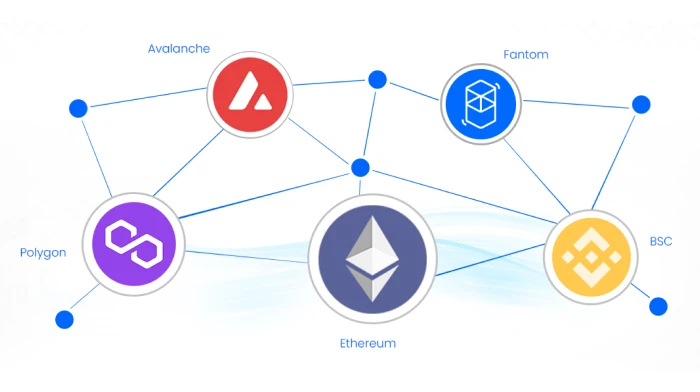
Introduction
The development of multiple blockchain platforms requires immediate solutions for secure network connections between different systems. The development of cross-chain solutions has become vital because they enable secure data and asset transfers between different blockchain systems which revolutionizes blockchain interoperability approaches.
These innovative solutions address critical security gaps in isolated blockchain environments while establishing the foundation for a truly interconnected digital ecosystem. Cross-chain technologies enable secure asset protection and transaction management between multiple networks which transforms blockchain technology into a more useful and accessible system.
Understanding Cross-Chain Security in Blockchain
The technology of cross-chain solutions consists of advanced protocols and systems which allow different blockchain networks to communicate seamlessly with each other. The systems enable safe data and asset exchange through standardized methods that preserve data integrity during network-to-network transfers.
The core functionality relies on various mechanisms including:
- Atomic swaps
- Multi-signature protocols
- Consensus algorithms
The technologies function together to build secure connections between blockchain networks which enable their collaborative operation with preserved individual security standards.
The importance of cross-chain solutions emerges when analyzing the constraints of independent blockchain systems. Isolated blockchain systems face multiple security risks because they remain vulnerable to single-chain attacks while having restricted data sharing capabilities and limited asset mobility. Cross-chain solutions establish protected routes for trusted transactions between different networks which enhances blockchain security and resistance to cyber threats.
Addressing Blockchain Security Risks in Isolated Networks
The security of isolated blockchain networks remains strong within their own boundaries yet they face specific security risks because they remain disconnected from other blockchain systems. The main security risk of isolated networks stems from concentrated attacks because attackers can target a single network without interference from other blockchain systems.
The main security risk of single-chain attacks exists because attackers can focus their resources on manipulating transactions or taking control of an isolated network. The concentration of attack vectors makes isolated blockchains highly vulnerable to coordinated cyberattacks which could compromise their entire security infrastructure.
The main restriction of isolated blockchains stems from their limited asset transfer capabilities. The inability to connect with other blockchain networks prevents these isolated systems from enabling free asset and data transfers which leads to operational inefficiencies and reduced functionality. Users encounter difficulties when trying to move tokens between different chains because this limitation restricts platform asset access and produces an inferior user experience.
The implementation of cross-chain solutions resolves these risks because they provide secure methods for networks to exchange information and data. Security responsibilities spread across multiple chains through these solutions which makes coordinated attacks extremely challenging to execute. These solutions create secure asset transfer systems which enable users to transfer tokens and data between chains without compromising security integrity.
Cross-Chain Protocols for Blockchain Interoperability
Atomic Swaps
Atomic swaps enable users to exchange assets directly between different blockchain networks through peer-to-peer transactions that do not need central exchange services. Smart contracts enable automatic swap cancellation when either party fails to meet their obligations thus ensuring total transaction security.
Users can exchange Bitcoin for Ethereum directly through atomic swaps without needing centralized exchanges. This method decreases fraud exposure while boosting security through the elimination of third-party dependencies which establishes a more secure and trustless trading environment.
Multi-Signature Wallets
Multiple private keys must validate transactions in multi-signature wallets to enhance security during cross-chain operations. These wallets implement multiple-party validation for transactions before chain execution which minimizes unauthorized transfer risks.
A standard implementation needs three out of five trusted parties to validate transactions before execution occurs. The implementation makes unauthorized transfers almost impossible to execute while providing strong protection for blockchain systems.
Hash-Locking
Hash-locking protects cross-chain transaction execution through smart contracts that lock assets until specific predetermined conditions become satisfied. Atomic swaps benefit from this technique to execute transactions simultaneously across both participating chains.
The hash-locking mechanism protects both users' tokens from different chains until they complete their entire agreement. The mechanism protects exchanges from partial transactions by maintaining atomicity across multiple networks which ensures secure transactions.
Notary Schemes
The validation of cross-chain transactions depends on trusted third-party nodes acting as notaries. The schemes operate with reduced decentralization because they primarily serve enterprise blockchain environments where pre-approved nodes verify transactions.
The notary scheme enables corporate consortiums to perform secure cross-chain transactions within trusted partner networks. This security approach enables controlled protection of business operations through established trust relationships.
The security of cross-chain operations depends on complete measures and protocols which protect data exchanges between different blockchain networks to enable secure transactions while blocking unauthorized access.
Consensus Mechanisms and Cross-Chain Security
Proof of Work (PoW) functions as a widely used consensus mechanism for securing cross-chain systems. The process of miners competing to validate transactions through complex mathematical problem-solving generates a highly secure environment because of the high computational barriers needed to modify data or manipulate transactions between interconnected chains.
The PoW consensus mechanism protects transactions verified on one chain from tampering when they are transferred to another network which maintains system-wide consistency and honesty.
The cross-chain security mechanism Proof of Stake (PoS) provides an alternative robust solution. The network becomes secure through validators who stake their assets as collateral because any malicious behavior leads to asset loss.
The security of cross-chain transactions improves through PoS because trusted validators form networks to verify inter-chain transactions while blocking unauthorized cross-chain operations.
Modern cross-chain systems use hybrid security mechanisms which include DPoS and BFT protocols. Users in DPoS systems can assign their voting power to specific nodes which validate cross-chain transactions thus adding an extra security layer through community-approved nodes.
BFT mechanisms provide strong security against node failures and malicious attacks through majority node agreement requirements which confirm transactions in adversarial conditions.
Cryptographic Techniques in Cross-Chain Security
Secure cross-chain transactions depend on cryptographic techniques to protect data during network transfers. The main defensive mechanism of encryption protects transaction data through encoding which prevents unauthorized access while allowing only authorized parties with decryption keys to access sensitive information.
The method establishes robust protection against unauthorized access while minimizing breach risks when data moves between different blockchain networks.
The hashing process generates distinctive digital fingerprints for each data block which enables instant detection of any tampering attempts. Any modifications made to transaction data result in a complete transformation of the corresponding hash value which immediately reveals inconsistencies while preserving data integrity.
Hashing enables cross-chain applications to establish secure verification and data consistency between chains which builds strong trust in cross-chain transactions through tamper-evident mechanisms.
Hash locking enhances cross-chain protocols through smart contract-based asset security which requires specific conditions to be met before asset release. The technique ensures all cross-chain transaction participants meet their obligations before asset release to provide complete transaction security.
Real-World Use Cases of Cross-Chain Security in Blockchain
Decentralized Finance (DeFi)
The security features of DeFi cross-chain enable users to conduct transactions on decentralized exchanges and lending protocols while their assets remain protected during cross-chain transfers. Polkadot and Cosmos provide secure cross-chain DeFi transaction capabilities by creating seamless connections between different networks.
The interoperability feature enables users to exchange tokens between different blockchains without security risks which increases DeFi service accessibility and enhances liquidity throughout the entire network.
Supply Chain Management
Cross-chain solutions provide complete tracking and verification capabilities for goods that move between multiple supply chain networks. Companies implement blockchain interoperability to monitor product origins and authenticity throughout their supply chain segments.
The cross-chain solutions provided by VeChain enable stakeholders to track product information across different networks while maintaining transparency and protecting sensitive data from unauthorized access.
Asset Transfers Across Platforms
Asset transfers including token exchanges and digital asset movements heavily rely on cross-chain security to function securely. The bridging networks of Chainlink and Wanchain provide secure cross-blockchain transfer capabilities which protect transaction data when operating between multiple networks.
The functionality serves as a critical requirement for users who want to transfer NFT assets or cryptocurrencies between networks while ensuring data integrity and preventing manipulation.
Inter-Banking and Payment Systems
The financial industry uses cross-chain security to develop payment networks which connect various banks and digital currencies for transaction processing. Ripple implements cross-chain solutions to develop worldwide payment systems which enable safe and efficient transactions between financial institutions across the globe.
Ready to Implement Cross-Chain Solutions?
Our blockchain security experts will help you develop customized cross-chain solutions which match your business requirements. Our team provides complete security solutions for blockchain infrastructure through atomic swaps and multi-signature protocols.
Conclusion
The advent of cross-chain solutions is a pivotal move towards the development of blockchain technology. These protocols and mechanisms overcome the constraints of isolated networks and deliver on an otherwise secure and reliable basis the possibility of real interoperability. Not only do they remedy the centuries long problem of data silos but they also put in place resilient structures that decentralize security responsibilities across networks and this makes it much more difficult to attack in the scale and exploit systemic vulnerabilities.
The practical use of cross-chain technologies by blockchain users is the safety of transferring tokens, more convenient DeFi services, ability to monitor supply chains, and the security of asset transactions between platforms. To businesses and financial institutions, they provide secure platforms through which value and information are free to flow without the need to sacrifice on either security or compliance. With these developments, blockchain is no longer a fragmented land but an interrelated ecosystem where all security standards can be shared.
Finally, cross-chain solutions do not simply provide an addition to the current blockchain infrastructure, but that is the direction to the new generation of digital systems. They combine consensus mechanisms, cryptographic protections, and interoperability protocols and provide an environment in which trust and scalability can co-exist. The institutions and the projects that adopt these solutions in the present days are in the front-line of a new decentralized economy, where security, transparency, and cooperation is the central pillars of growth.


